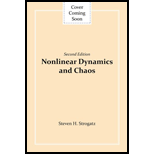
Concept explainers
Interpretation:
For the complex
Concept Introduction:
The index of a closed curve C is an integer that measures the winding of the vector curve C is an integer that measures the winding of the vector field on C.
The index also provides information about a fixed point that might happen to lie inside the curve.
Index theory provides global information about the phase portrait
The index of the closed curve C can be defined as the net number of counterclockwise revolutions that are made by the vector field.
Answer to Problem 11E
Solution:
The vector field for
The vector field for
The vector field for
It is to be shown that origin is the only fixed point.
The vector fields will have
Explanation of Solution
Index theory provides global information about the phase portrait. The index of the closed curve C can be defined as the net number of counterclockwise revolutions that are made by the vector field. Mathematically, it can be expressed as:
Here,
Consider complex vector fields as,
Here, k is an integer and is greater than0. Also,
Let,
The Euler’s formula is given as,
a)
Write the vector fields in both Cartesian and polar coordinates for different cases
Case 1)
Solve for
Substitute, 1 for
Substitute,
Substitute,
Here,
And,
Thus, the Cartesian and polar co-ordinate for this vector field is
Solve for
Substitute, 1 for
Substitute
This is the Cartesian co-ordinate for this vector field.
Solve for polar coordinates.
Substitute,
Substitute,
Thus, the Cartesian and polar coordinates for this vector field are
Case 2)
Solve for
Substitute,
This is the Cartesian co-ordinate for this vector field.
Solve for polar coordinates,
Substitute,
Substitute,
Thus, the Cartesian and polar co-ordinate for this vector field are
Solve for
Substitute 2 for
Substitute
This is the Cartesian co-ordinate for this vector field.
Solve for polar coordinates.
Substitute,
Substitute,
Thus, the Cartesian and polar coordinates for this vector field are
Case 3)
Solve for
Substitute,
This is the Cartesian co-ordinate for this vector field.
Solve for polar coordinates,
Substitute,
Substitute,
Thus, the Cartesian and polar co-ordinate for this vector field are
Solve for
Substitute, 3 for
Substitute
This is the Cartesian co-ordinate for this vector field.
Solve for polar coordinates.
Substitute,
Substitute,
Thus, the Cartesian and polar coordinates for this vector field are
b)
It is to be shown that origin is the only fixed point
Take case 1 as
Substitute,
Substitute,
The index can be calculated as,
For the vector field
For the vector field
c)
Let us generalize that this result for
Want to see more full solutions like this?
Chapter 6 Solutions
Nonlinear Dynamics and Chaos
- Use the inner product u,v=2u1v1+u2v2 in R2 and Gram-Schmidt orthonormalization process to transform {(2,1),(2,10)} into an orthonormal basis.arrow_forwardProve that in a given vector space V, the zero vector is unique.arrow_forwardConsider the vectors u=(6,2,4) and v=(1,2,0) from Example 10. Without using Theorem 5.9, show that among all the scalar multiples cv of the vector v, the projection of u onto v is the closest to u that is, show that d(u,projvu) is a minimum.arrow_forward
- Illustrate properties 110 of Theorem 4.2 for u=(2,1,3,6), v=(1,4,0,1), w=(3,0,2,0), c=5, and d=2. THEOREM 4.2Properties of Vector Addition and Scalar Multiplication in Rn. Let u,v, and w be vectors in Rn, and let c and d be scalars. 1. u+v is vector in Rn. Closure under addition 2. u+v=v+u Commutative property of addition 3. (u+v)+w=u+(v+w) Associative property of addition 4. u+0=u Additive identity property 5. u+(u)=0 Additive inverse property 6. cu is a vector in Rn. Closure under scalar multiplication 7. c(u+v)=cu+cv Distributive property 8. (c+d)u=cu+du Distributive property 9. c(du)=(cd)u Associative property of multiplication 10. 1(u)=u Multiplicative identity propertyarrow_forwardFind a basis for R2 that includes the vector (2,2).arrow_forward
 Elementary Linear Algebra (MindTap Course List)AlgebraISBN:9781305658004Author:Ron LarsonPublisher:Cengage Learning
Elementary Linear Algebra (MindTap Course List)AlgebraISBN:9781305658004Author:Ron LarsonPublisher:Cengage Learning Linear Algebra: A Modern IntroductionAlgebraISBN:9781285463247Author:David PoolePublisher:Cengage Learning
Linear Algebra: A Modern IntroductionAlgebraISBN:9781285463247Author:David PoolePublisher:Cengage Learning Algebra and Trigonometry (MindTap Course List)AlgebraISBN:9781305071742Author:James Stewart, Lothar Redlin, Saleem WatsonPublisher:Cengage Learning
Algebra and Trigonometry (MindTap Course List)AlgebraISBN:9781305071742Author:James Stewart, Lothar Redlin, Saleem WatsonPublisher:Cengage Learning- Algebra & Trigonometry with Analytic GeometryAlgebraISBN:9781133382119Author:SwokowskiPublisher:Cengage



